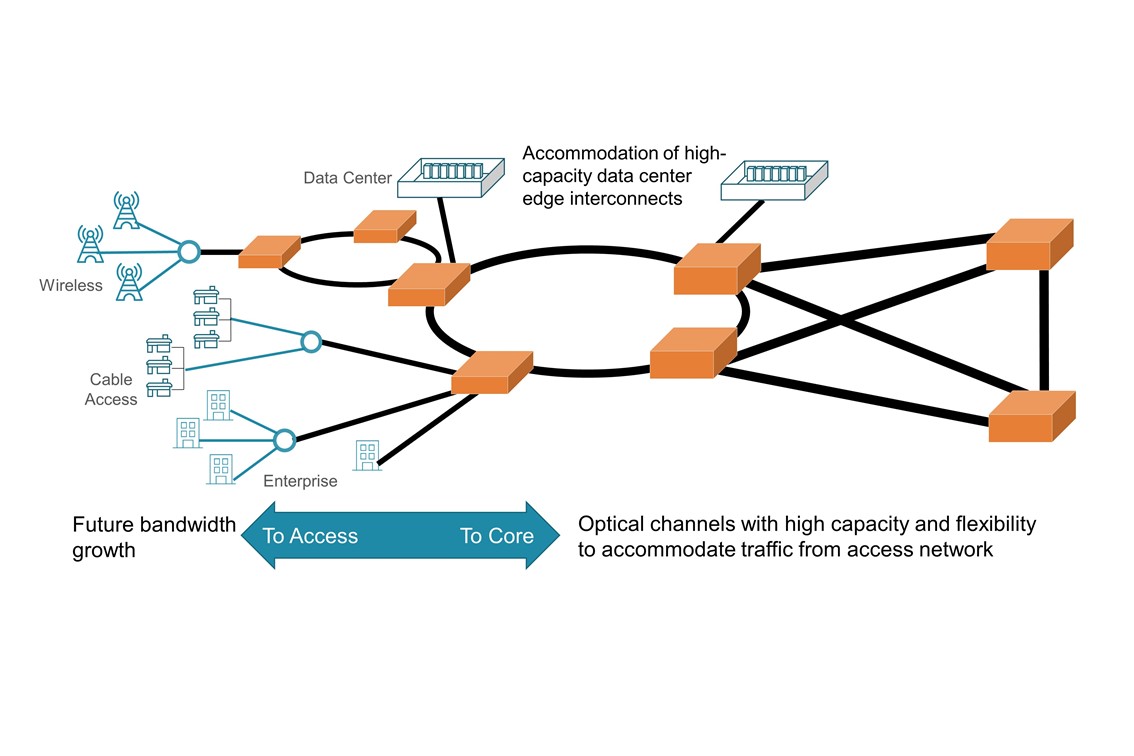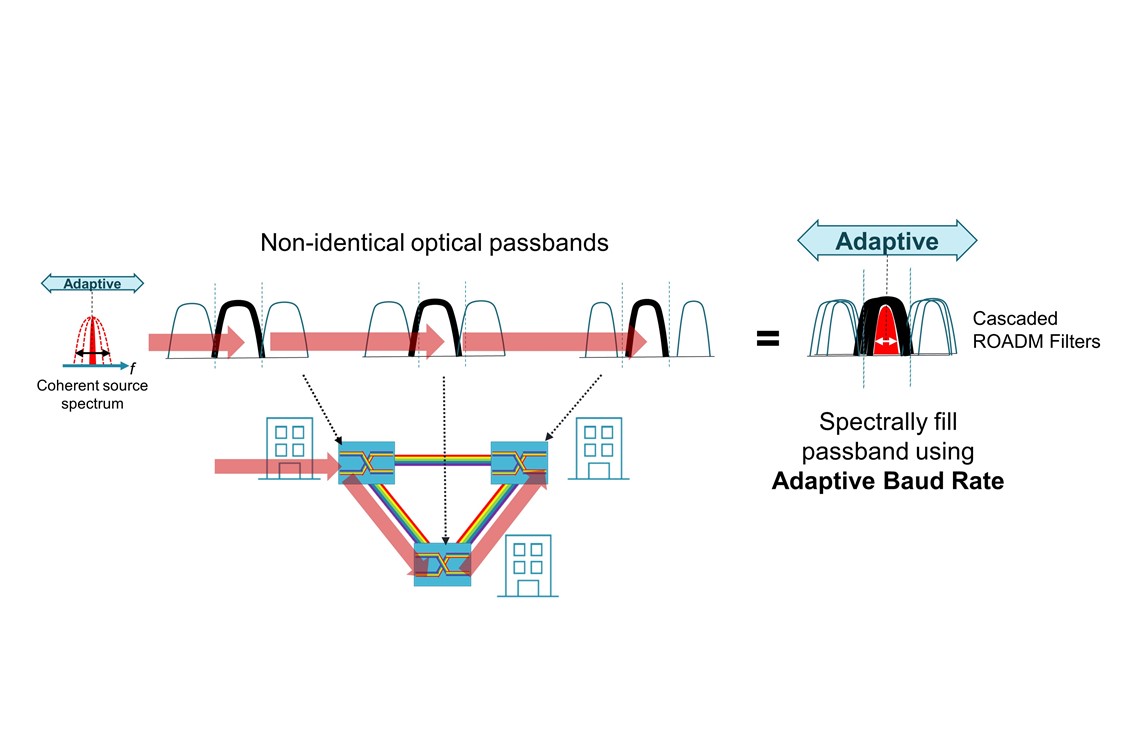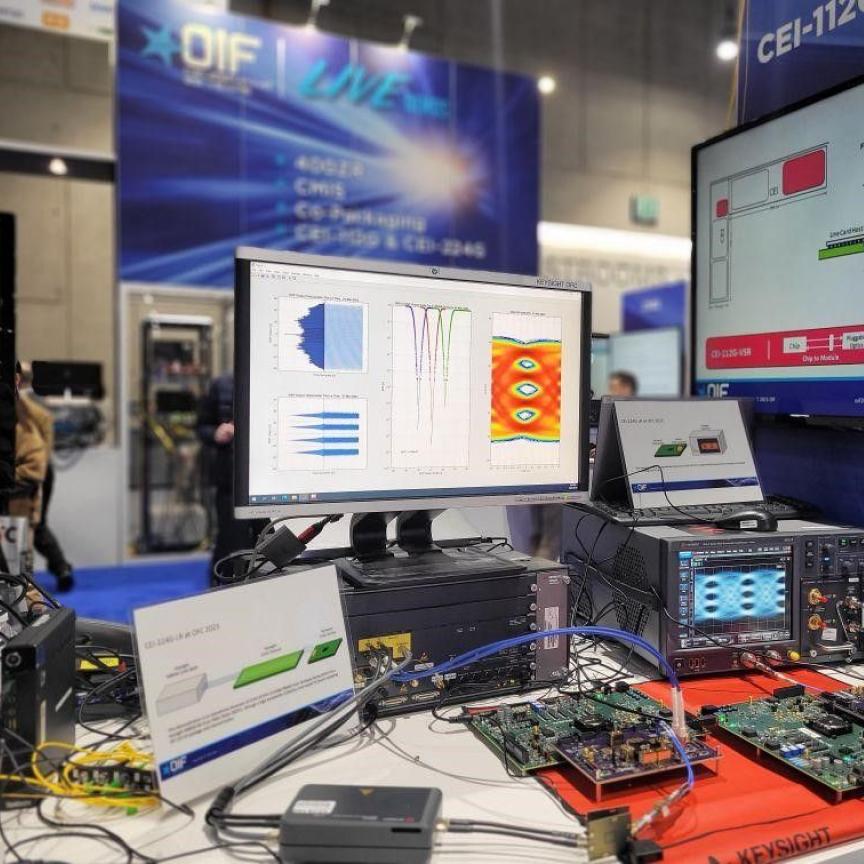Network core flexibility will become just as important as capacity for future networks, and coherent solutions could be key to accommodating changing traffic flows, argues Eugene Park
Increasing bandwidth demand is nothing new in the optical networking industry, but where that demand comes from is changing, and this is going to strain current network core architectures. With the emergence of new applications such as 8k ultra-high-density video, 5G, and the Internet of Things (IoT), even greater bandwidth is going to be required at the network edges.
The required optical channel capacities to support shifting edge and access traffic may exceed legacy installed bandwidth, and network operators may not be able to fully predict in advance the required channel capacity the further we move away from the network core. Deploying a flexible network core architecture allows the handling of the increased traffic from the edge and access, as well as traffic non-uniformity that might arise–fatter core pipes are available dynamically as they are needed.
This article takes a look at how optical coherent solutions will be critical to accommodating these changing traffic flows, explains why flexibility in the network core will become just as important as capacity, and highlights strategies for building these higher-performing and flexible networks in the future.

Figure 1: Growth at the network edge will affect network core requirements
Architecture evolution
The industry may not have a crystal ball, but it’s clear that network traffic is becoming more fluid. Applications of coherent 100G and 200G solutions are already being used for aggregated access traffic, and in the future, there will be 400G and potentially even higher transmission speeds feeding into the core of the network.
This fluid traffic will make it more difficult to anticipate bandwidth demands from 5G, cable Remote PHY, and data centre edge networks. One way to address this problem is putting in place network elements that can accommodate dynamic, and maybe unpredictable, traffic patterns from the edge and access network. Optical coherent solutions in particular will play a key role in meeting this new traffic demand by increasing performance and flexibility in the network. Coherent solutions will also play a role in the edge and access networks – requiring smaller form factors and standardised interoperable interconnects – driven by growing bandwidth needs at the network edge.
Optimising network capacity and reach will be a key requirement for future flexible core networks, but it needs to be done in a way that provides low total cost of ownership so operators can maximise their return-on-investment.
To accommodate varying traffic from the edge into the core, a network may require different optimisation requirements in different parts of the network. For example, a leased optical interconnect linking two data centres may require the highest raw capacity achievable for low cost-per-bit between sites. Another example requiring flexibility is in metro or long-haul core environments with disparate channel impairments spanning a metro and/or long-haul link that require filling up the available spectral channel with a flexible control mechanism to optimise fibre use. This optimisation is critical when dynamic network reconfiguration is required to reroute optical channels for capacity reallocation or node failover onto alternate routes. Finally, for a long-haul or submarine link, achieving highest spectral efficiency may be the primary network requirement.
Coherent technology is well-suited to address these different requirements. For example, recent advances in coherent technology enable software control of the modulation mode and baud rate, which then allows the same hardware to be used in multiple parts of a network (edge, metro, long-haul, and submarine) resulting in a cost-effective way for network operators to scale their networks. Control of channel width, enabled by flexible reconfigurable optical add-drop multiplexers (ROADMs), is also key to a flexible core network. Here, we focus on the coherent transmission element of the network.
The rise of transmission shaping technologies
Another recent advancement that supports network optimisation is the use of coherent transmission shaping technologies – essentially, taking the software control of modulation mode and baud rate to a higher level of granular control. These technologies add an increased level of network flexibility and optimisation control, turning capacity gaps into usable bandwidth by adapting the optical transmission to the network. 3D shaping is one example of this approach. This enables flexible fine-tuning of the line-side optical transmission, allowing network operators to optimise capacity, reach, and spectral utilisation. It is a power-efficient technology solution that pushes optical transmission capacity closer to the Shannon limit.

Figure 2: Three elements of 3D shaping
There are three benefits of 3D shaping: increase of capacity by shaping constellation points’ probability with Fractional QAM; increase of reach by shaping constellation points’ location; and maximisation of channel passband usage by shaping spectral width with adaptive baud rate.
Shape the constellation, increase capacity
Typical coherent modulation modes such as QPSK, 8QAM, and 16QAM use integer bits/symbol steps (e.g., QPSK = 2 bits/symbols, 16QAM = 4 bits/symbols). Higher modulation-order modes (higher bits/symbols) provide higher capacity at the expense of reach, while lower modulation-order modes (lower bits/symbols) provide lower capacity with farther reach. Integer bits/symbol steps may result in sub-optimal capacity use due to link margin gaps. Fractional QAM modulation enables non-integer steps, supporting many small increments between the integer steps. With this feature, the link margin can be optimised with much greater resolution than traditional interconnect technology.
Improved channel performance
Greater resolution of transmission baud rate with a wide range provides the benefit of optimising spectral passband utilisation of an optical channel while enabling the use of lower modulation order operation to improve channel performance. In previous generation implementations, the baud rate of the coherent interconnect can be selected among a small number of settings. Having flexible continuous adaptive baud rate control gives network operators greater control to optimise channel passband use, especially important when channel passbands vary between links within the same network.

Figure 3: Filling up the available channel spectrum with adaptive baud rate
Advanced transmission shaping solutions such as 3D shaping enable the optical transmission technology to adapt to the network characteristics, accommodating a range of capacity and reach requirements while improving network utilisation.
Feeding into the core
Coherent solutions are also being deployed in edge/access aggregation networks. Today, pluggable coherent solutions supporting 100G and 200G links are already being used for transporting aggregated traffic into the core. In some cases, these modules are plugged directly into switches and routers, enabling IP-over-DWDM architectures.
Looking to 400G, edge DCI applications are expected to use modules based on the 400ZR standard currently under development at the Optical Internetworking Forum (OIF). This interoperability standard targets modules using 400G client optic form factors, such as QSFP-DD and OSFP, for reaches of 80km and above. The CFP2-DCO form factor is expected to be used for access and metro applications that require higher performance than 400ZR.
Edge/access network deployments to accommodate growing bandwidth demands may lead to a wider adoption of 100G/200G coherent aggregation links, with 400ZR on the horizon, using cost-effective pluggable modules. As we highlighted in this article, these links will need to feed into a flexible core network that can be reconfigured in response to varying link capacity requirements. Coherent multi-haul solutions shine in these core networks because they provide performance, flexibility, and network optimisation. Network operators are planning to leverage all of these solutions to scale networks in capacity from the edge to the core in order to achieve terabit speeds and beyond.
Eugene Park is senior manager, technical marketing at Acacia Communications


